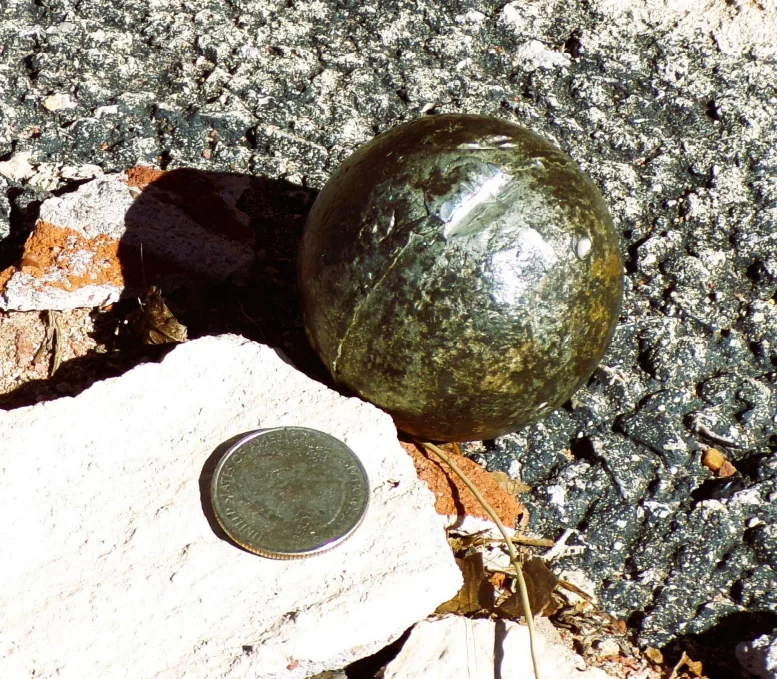
In last week’s column about the Spanish presence in Brown County, I quoted Jay Longley’s remembrance about a Spanish cannonball made of silver that was found inside the city limits of Brownwood. As it turns out, the full story of this local treasure tale has not been lost forever, as many often are. In fact, Frank Griffin, an area history buff and longtime resident, has this very artifact in his possession. Frank was generous enough to meet up with me and tell the story of how it was found and what he thinks about its possible history. I was astonished and delighted to be able to hold this item in my hand, learn what is known about it, and to imagine what its entire story might be. Hopefully you can get some of that same feeling from reading Frank’s amazing account of this remarkable discovery.
Griffin recalled the cannonball’s was unearthed around 1974, in the old section of Brownwood. “Dad bought two houses side by side, and he was putting in new chain link fence down the middle. I was in college then, and I would go there about 4:30 and put up equipment and clean up, that way they could work right up to 5:00,” Griffin said. “Well, I drove up one day and one of the guys handed me that. He said ‘hey I found this digging a post for the chain link fence.’ You can see where the shovel hit it. He said he thought it was a babbitt, which is what they use in ball bearings. I stuck it in my pocket. I never thought anything about it. For years, it sat upon my shelf. Then one day I noticed it just doesn’t look like lead. It’s too hard to be lead or a babbitt, which is a combination of lead and tin, I think. So I took it down to Nathan’s [a local jeweler], and they did a test on it. They said it was silver, higher than sterling, so it’s about 90 percent silver. I think it probably came from a Mexican pack train.”
“You can see an imprint of cloth or weave in it. With the wear on it, it almost looks like it was carried around. You can see the mold mark. I can’t think of any reason that an American settler would have had a mold that looked like that,” Griffin said. Frank has done a good bit on research on the possible history of what he believes to be a cannonball, a small cannonball. The closest thing to what he has seems to be a cache of cannonballs found in the wreck of French explorer La Salle’s ship the Belle. The 1686 wreck of the Belle was discovered in Matagorda Bay in 1995. It was excavated by the Texas Historical Commission, and nearly a million artifacts were retrieved, including a swivel gun, and interestingly, a cache of cannonballs in a wicker basket, perhaps not unlike the material of whatever left the pattern imprint on Frank’s cannonball. One of the commissions La Salle had from the French king was to discover and take control of the Spanish silver mines found in northern Mexico, according to Texas Beyond History’s website.
“It’s the right diameter for a swivel gun,” Frank said. I looked at the images of the Belle’s cannonball cache, and have to agree. The right size. The same seam line on the balls that appears on Frank’s specimen. Only the material is different. The Spanish claimed Texas as a territory in 1519. It’s difficult to imagine how this cannonball got to Brownwood, but of course we’re going to try. Naturally, Texana author J. Frank Dobie, the king of Texas treasure tales, is going to make an appearance here, in Griffin’s speculation on what might have happened.
“J. Frank Dobie thought Jim Bowie was not actually looking for a Mexican mine, that he was looking to waylay a Mexican smuggling pack train,” Griffin said. “Because the Mexican silver mines were down sort of west of Del Rio, down in that area. Anything they produced they had a twenty percent tax from both Mexico and Spain. So what they would do, they would smuggle it up a river called the Concho River, not ours but the one in Mexico, float north into the Rio Grande, and then they would come up the Frio River, jump across about 30 miles from the headwaters of the San Saba River, down the San Saba River to the Colorado River, to what was called the Smuggler’s Road. They would go from there to New Orleans, sell the silver, and send orders to Europe for manufactured goods which would be delivered to Mexico. That way, they avoided that twenty percent tax.”
Of course, no one can say with certainty how this metal ball ended up in someone’s yard in Brownwood, to be discovered by a work crew possibly centuries after it was lost. Was the famous adventurer Jim Bowie somehow involved? Did Spanish explorers try to disguise this piece of silver by casting it as a common cannonball? Could the Comanche or Kiowa have attacked a Spanish wagon train and discarded a seemingly useless metal ball afterward? Is it possible there is a link between someone on La Salle’s ship and the Brownwood find? I suggest a cup of hot coffee, a comfy chair and a copy of the immortal J. Frank Dobie’s lost Texas treasure book, Coronado’s Children, to assist anyone inclined to try solving the riddle of Brownwood’s silver cannonball.
***
Diane Adams is a local journalist whose columns appear Thursdays on BrownwoodNews.com. Comments regarding her columns can be emailed to [email protected].
